If you register a destination in the Local Address Book, you can save yourself the effort of entering the destination every time it is used. That destination can also be selected from the Local Address Book for use in any other customized setting.
You can store the I-fax address, the mode, and the destination conditions in the Local Address Book.
The Local Address Book is a feature used for storing fax, e-mail, I-fax, and file server destinations. The Local Address Book is divided into 10 Address Lists and one-touch buttons. You can store up to 1,800 destinations, including 1,600 destinations in the Local Address Book, and 200 destinations in one-touch buttons. Registering a destination in the Local Address Book saves you the effort of entering that destination's address each time you send a job.
By storing your own e-mail address, you can specify a reply-to e-mail address and use the Job Done Notice function.
|
NOTE
|
|
For instructions on registering a fax number, see "Storing Fax Numbers in Address Book (Local)."
Since each address entry is treated as a single entry, if an e-mail address is registered in a group address, that e-mail address and the group address are counted as two entries.
Destinations stored in the Address Book can be exported to your computer as a file, which can later be imported in the machine. For information on exporting the Local Address Book, see "Saving/Loading the Address List."
If you want to manage destinations with the Manage Address Book Access Numbers mode, set the Manage Address Book Access Numbers in Set Destination (Settings/Registration) to On. (See "Access Number Management.")
If there is any required destination setting that has not yet been set after registering the access number, the screen for specifying the destination settings is displayed again.
You can enter up to seven digits for the access number. If you enter fewer than seven digits, the machine stores the access number with leading zeros.
Example: If <321> is entered, <0000321> is stored. You cannot store an access number with only zeros as the number, such as <0000000>. If you enter a number that begins with zeros, the leading zeros are ignored. Example: If <02> or <002> is entered, <0000002> is stored. |
1.
Press [Address Book].
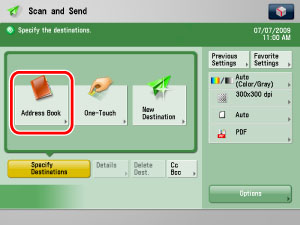
2.
Press [Register].
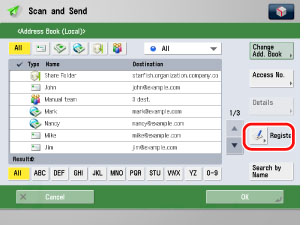
3.
Press [Register New Dest.].
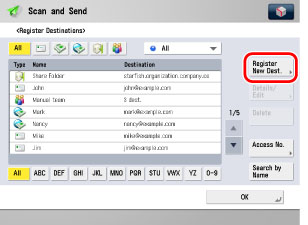
4.
Press [I-Fax].
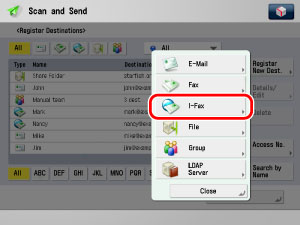
5.
Press [Name] → enter a name of the I-fax address → press [OK].
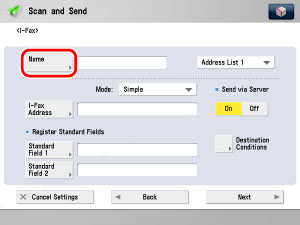
|
NOTE
|
|
If you want to search the destination, search is performed using the text entered here. To search, you can sort the destination by the initial letter or narrow the search for destination by using a maximum of 24 characters. For more information on refining the destination, see "Specifying Destinations Using the Address Book (Local)."
|
6.
Press the Address List drop-down list → select one of the numbered Address Lists.
Address Lists 1 to 10 are used to divide the Address Book into 10 parts. This is a convenient way to classify destinations.
The I-fax address that you enter will be stored in the Address List that you select here.
7.
Press the Mode drop-down list → select [Simple] or [Full].
|
[Simple]:
|
Sends scanned data as an image via the Internet.
|
|
[Full]:
|
Sends scanned data as an image via the Internet, and enables you to receive a delivery confirmation message telling you whether your I-fax was sent successfully.
|
In order for you to receive a confirmation message telling you the delivery status of your I-fax document, the recipient's machine must have I-fax capabilities and be compatible with the Full mode.
|
NOTE
|
|
If you send documents using the Full mode to a machine that does not support the Full mode, delivery confirmation cannot be carried out. When this happens, the job concerned is not considered as complete even though the actual sending of the document is successful. Such jobs are displayed as <Waiting for TX result...> on the Status Monitor/Cancel screen until the time set for Full Mode TX Timeout in E-Mail/I-Fax Settings in Send in Function Settings (Settings/Registration) has lapsed. After the timeout, the job is moved to the log, and the result is shown as <-> when sending of the document to a server or other destination could not be verified.
|
8.
Press [I-Fax Address] → enter the I-fax address → press [OK].
|
NOTE
|
|
If you do not send documents via a server, and if the recipient's IP address is not registered with a DNS server, enter the domain name in the following format: (user)@(the recipient's IP address).
|
9.
Press [Standard Field 1] and [Standard Field 2] → enter their respective standard fields → press [OK].
Standard Field 1 and Standard Field 2 are settings required for using an Internet fax service. For details, contact your service provider.
If you do not use an Internet fax service, this step is not necessary.
|
NOTE
|
|
After pressing [OK], the standard field that you entered appears as asterisks (********) on the I-Fax Settings screen.
|
10.
Select [On] or [Off] for <Send via Server>.
|
[On]:
|
Sends documents via a server. You can send documents to destinations via the Internet in the same way as e-mail.
|
|
[Off]:
|
Does not send documents via a server. You can send large amounts of image data to a recipient within the same LAN (Local Area Network) environment without placing a burden on the mail server. This enables you to send documents quickly and directly to the recipient. To use this setting, it is necessary to set up an MX (Mail eXchange) record on the DNS server. Ask your System Manager whether this type of sending is possible before you set Send via Server to 'Off'.
|
If you specify the Standard Field settings, set Send via Server to 'On'.
|
IMPORTANT
|
|
To be able to specify the Send via Server setting, set Use Send via Server to 'On' in E-Mail/I-Fax Settings in Send in Function Settings (Settings/Registration) beforehand. If Use Send via Server is set to 'Off', <Send via Server> is grayed out and cannot be pressed. (See "Use Send Via Server.")
It is recommended to set Allow MDN Not via Server to 'On' in E-Mail/I-Fax Settings in Send in Function Settings (Settings/Registration). (See "Allow MDN Not Via Server.")
|
|
NOTE
|
|
Even if <Send via Server> is set to 'Off', delivery confirmation of documents sent using the Full mode is carried out via the server.
|
11.
Press [Destination Conditions].
12.
Select [On] or [Off] for <Divide Data>.
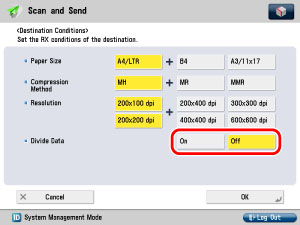
|
[On]:
|
Select [On] if the destination machine has a function to combine divided data. If the size of the data being sent exceeds the value set for [Maximum Data Size for Sending] in E-Mail/I-Fax Settings in Send in Function Settings (Settings/Registration), the data is divided into multiple parts before being sent. Once the destination machine receives all the parts of the data, it combines them into one item of data.
|
|
[Off]:
|
Select [Off] if the destination machine has no function to combine divided data. If the size of the data being sent exceeds the value set for [Maximum Data Size for Sending] in E-Mail/I-Fax Settings in Send in Function Settings (Settings/Registration), a sending error occurs.
|
|
IMPORTANT
|
|
Set the destination conditions according to the specifications of the recipient's machine. An error in transmission may occur if you set conditions that the recipient's machine does not support.
|
|
NOTE
|
|
For more information on the maximum data size for sending, see [Maximum Data Size for Sending] in E-Mail/I-Fax Settings in Settings/Registration. (See "Maximum Data Size for Send.")
|
13.
Finish storing the address.
Press [Next].
Press [Access No.].
Press [Access No.] → enter the access number using  -
-  (numeric keys).
(numeric keys).
 -
-  (numeric keys).
(numeric keys).Press [Confirm] → re-enter the access number for confirmation using  -
-  (numeric keys) → press [OK] → [OK].
(numeric keys) → press [OK] → [OK].
 -
-  (numeric keys) → press [OK] → [OK].
(numeric keys) → press [OK] → [OK].If you do not want to set an access number for this destination, press [OK] without entering any number.
Press [OK].